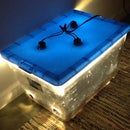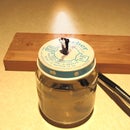Introduction: Mickey Mouse Holding Your Mailbox
A good friend of our family is a huge Mickey fan. The inside of her house, her desk at work, her car, and lots of other things in her life are Mickey themed. The outside of her house didn't have a trace of Mickey. For her birthday we wanted to do something for her that was Mickey, slightly over the top, and she could use everyday.... The Mickey mail box was born. It ended up being just over 5 feet tall, 4-5 in thick, and weighs just over 110 lbs.
I had a bit of help with this project, the art was created by Don, in a black and white sketch. My two girls and my wife lent extra sets of hands when needed, and helped out with some of the painting.
The variations on this are limitless, and our friend has already requested Pluto to hold her paper. I hope this inspires you to create something unique for your mail box and tick off the home owners association. One draw back to a project like this is it will stop traffic on your street, and possibly cause a photo shoot by complete strangers in your front lawn.
Click on the next step and lets get started.
Step 1: Choose Your Art and Adjust for Box Height
First you will need to decide what art you will use.
Once you find a good piece of art or create one yourself, you will need to see if the height of the box will land within the post offices' regulations:
http://faq.usps.com/eCustomer/iq/usps/request.do?create=kb:USPSFAQ&view%28%29=c[c_usps0916]&varset%28source%29=sourceType:embedded
"Generally, the boxes should be installed with the bottom of the box at a vertical height of between 41-45 inches from the road surface."
I used Photoshop with the guide rules on to determine the height of the box. To do this I scaled my picture size to around 5 in and assumed that 1" on the picture would be 1 foot on the real thing. Don't worry about getting this exact, I will show you how to adjust it to fit when enlarging it to full size.
If your art is black and white like mine was adding color for reference could be helpful
Step 2: Materials
With the art out of the way its time to pick up materials.
2 sheets - John Hardy backer board (drywall area, but used for tile)
scrap 1/2" ply wood, you may be able to get an associate at your local home improvement store to give you some that they use to protect other wood.
5 - Treated 2"X4"X8'
1 - 4"X4"X8'
1 box Hardy board screws
1 small box thinset (tile adhesive to fill the screw holes)
1 box 3" deck screws
1 tube construction adhesive
1 tube calk
1 can KillZ primer (water based, but oil is better)
1 medium can white Rust-Oleum.
1 small can black Rust-Oleum
1 can each color spray paint that you need + 1 can of clear
2 tubes calking
2 rolls masking tape 1" wide
bunch of news papers, you can't use your Ipad to mask off Mickey.
2 lag bolts 5" long 3/8" diameter with larger fender washers
Tools need:
enlarger or overhead projector (search instructables they have lots of ideas)
sharpie marker
small clamp
screw gun (drill)
saw
sword stripper pin striping brush.
putty knife (to fill the screw holes)
calk gun
Step 3: Project the Image and Cut Out the Faces
Set up your projector and art to hit your hardy backer board. This is where you can set the exact mail box height. Measure up from the bottom of the board and mark a line 42", and adjust the projector. This will be where you want the top of Mickey's hand to be. It will ensure you meet the post office regulations. Using a sharpie marker, sketch out the outline of Mickey. We got a bit carried away and added in the rest of the detail. All you really need is the outline. This is a good time to sketch in your basic structure to get an idea what you would like for support. If you plan on making Mickey the full structure is shown in following steps.
Once you have the outline you are ready to cut. A Bosch jig saw with a diamond blade was used to cut out the outline. The standard bi metal blades wore down in a few feet of cutting due to the abrasiveness of the material.
A vacuum is recommended along with safety glasses, and a rated dust mask. Read the manufactures instructions on the their material. A second person here to hold the vacuum while you cut is helpful and keeps the dust down.
Step 4: Create the Frame, Attach the Faces
Now that the faces are cut you will need to create the frame. Use treated wood if you would like to extend the frame life.
Make sure the wood is dry, if it has lots of moisture you will seal it in with the painting steps and the moisture escaping from the wood will try to lift the paint.
Lay one of the hardy board faces smooth side down on the ground and lay out the frame. DO NOT glue the frame to the bottom face yet. When you have the frame complete you will put construction adhesive on the side of the wood facing up and lay the 2nd face on it rough side toward the adhesive. Having a second person is helpful here. Align the upper face to the lower face and start putting in screws.
You will need to stand Mickey up and flip him over to attach the face that is laying on the ground. The second pic in this step is standing up Mickey ready to flip him over and attach the other face. It also shows you the almost complete frame.
Step 5: Calk, Prime, and Paint
It is a good idea to add calking where the faces met the frame just to keep water out of the structure.
Next came the primer; this step is perfect to include the rest of the family who "want to help too....sniff, sniff"
Open a drop cloth over the floor, cover the kids from head to foot, and follow behind them smoothing out the drips.
Killz primer was used here to seal and prep for paint.
After the primer had dried, a brushed coat of white Rust-Oleum was applied and let dry.
Step 6: Re-sketch the Lines and Tape.
You will need to reset up the projector to transfer the line to the primed and painted Mickey. Use a sharpie marker to trace the lines from the projector. Take your time the cleaner the lines are in this step the easier it will be to cover them with black paint using a pin stripping brush.
The picture here shows yellow and red over spray, this is from the other side. The picture was taken after I did this step to the other side.
Let the white base coat completely dry before going on to this step>>>>>IF you do not let the paint dry it will peel.
Now you will need to tape off one of the colors for paint. Try to start with the largest and lightest color first, or with one that will be surrounded by black.
The mouth was done first, and then the feet. Put masking tape (brown type to see the sharpie lines through) over the sharpie lines and use a razor blade to cut the tape to the sharpie lines. Be careful not to cut through the white top coat. Once the tape is ready, paint it light coats with some drying time in between. Pull the tape after you have painted the last coat and the paint is still slightly wet. The angle matters if you pull the tape toward what you have painted you can pull off paint.
Step 7: Paint the Colors
Let Mickey dry between coats.
Once the yellow is complete tape off the red pants, and paint.
The black is last, use the same procedure as for all of the other colors.
Once the black is done you move on to the finish work. This is where you use a pin stripe brush to put the lines back on. You may again need to set up the projector to get the lines where you want them. Thinning the black paint out allows the pin stripes to flow better. You can use a small paint brush, but I have found the pin stripe brush gives a cleaner line. It takes a bit of practice, but you can get the hang of it. You probably wont be striping any motorcycles in the near future, but it will look great on Mickey. You can get the brushes on line or at your local automotive paint shop.
A small brush to finish up the eyes and buttons will be needed. You will need to triple coat the white on the buttons to go over the red, or you could mask them off in the first place.
When you are completely done, a clear coat over the entire project will seal out any cuts you may have made in the paint during masking.
Step 8: Ready Mickey's Home
We used existing rock to make a small cove for Mickey to fit in.
4X4 post was sunk in the ground 48" to be below frost. We measured from the ground up the same distance as the block is in step 4. We added 2 inches to allow for sink and to keep Mickey out of the ground. We added pea gravel around him this will help keep water off the bottom of his feet.
Step 9: Set Mickey
Find a friend or the birthday girl and unload Mickey from a large vehicle. Place Mickey on the post. If we did everything correctly Mickey will slide on the post bottom out on the block and sit just above the pea stone. 2 lag bolts through the front of Mickey's 2X4 support structure and you should be all set. Inspect the hole in Mickey that the post will go into before getting ready to install him. We found one screw tip sticking out into the hole that would have made it very hard to install.
Step 10: Add on Your Mail Box
Since a paper box was a must, and was not known in the design phase a double mailbox plate was made with 3 pieces of plywood. one for the base that is as wide as both and 2 that each fit under the mailboxes. If you are only using one mail box, a simple kit can be purchased from a home improvement store. Simply screw the board or kit to the top of Mickey's hand, slip the mail box over it, and screw it through the sides of the box.
I hope you enjoy this project as much as I did. Maybe Pluto with be an add on instructable.

Participated in the
4th Epilog Challenge













